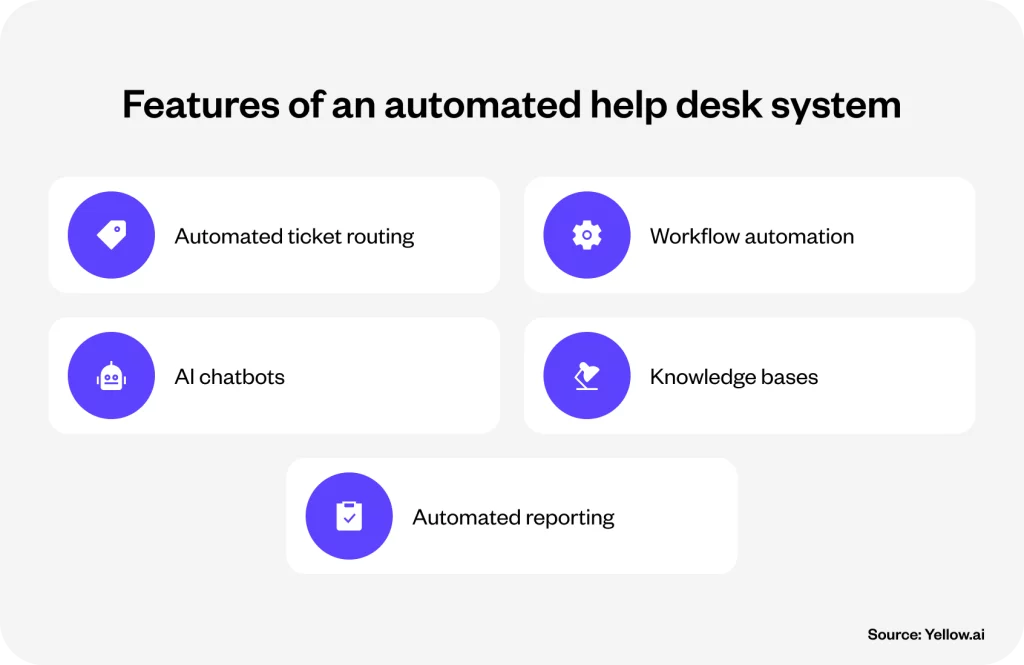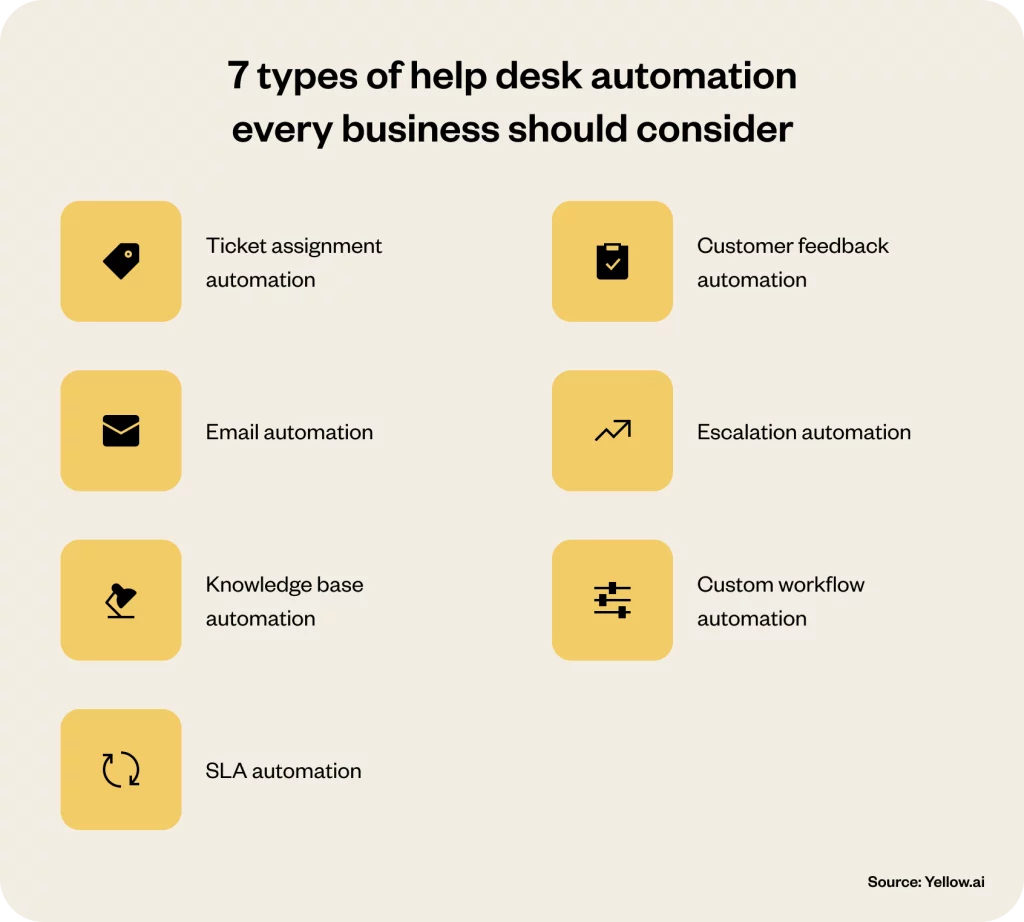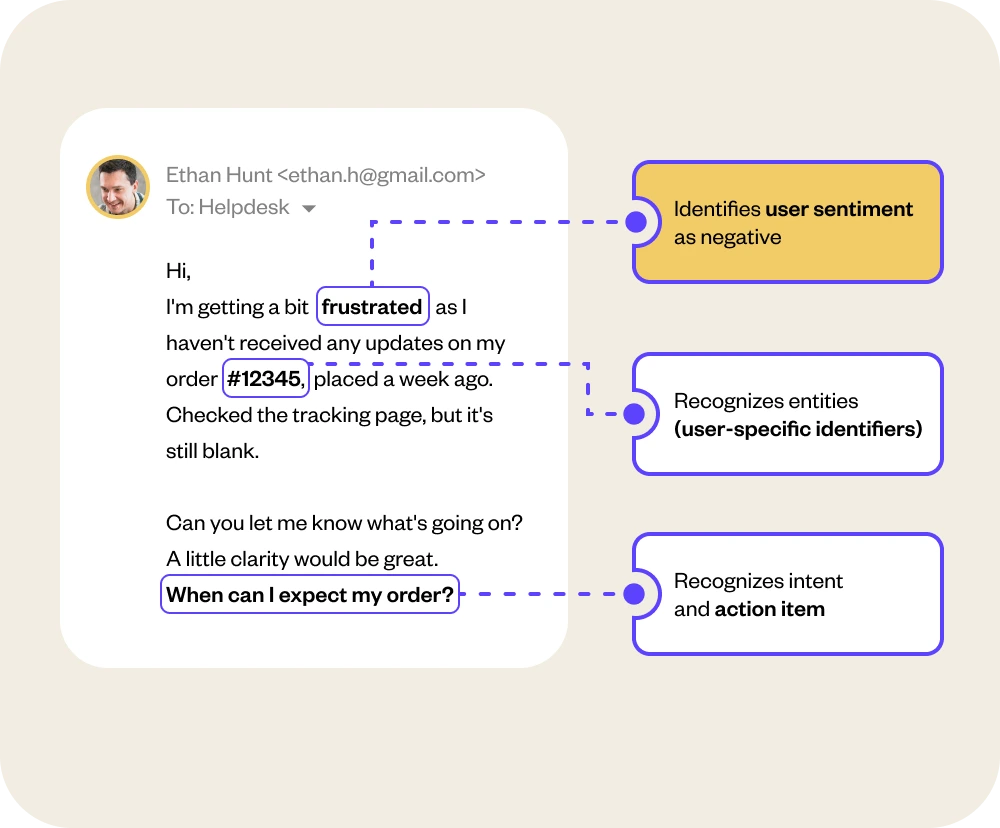Summary
As we navigate the complexities of the digital age with generation-now customers, help desk automation is empowering contact center teams across industries navigate the ebb and flow of customer demands with unprecedented agility, and help brands accelerate their customer service from ordinary to extraordinary. With customer expectations at an all-time high, the ability to respond swiftly and effectively is paramount. A recent HubSpot survey highlights the critical nature of these expectations: 90% of customers rate an “immediate” response as essential, with “immediate” often meaning within 10 minutes or less. This level of responsiveness is no longer achievable solely through human efforts.
If your enterprise has not yet fully embraced automation within your customer support framework, you may be missing out on substantial opportunities to boost efficiency and significantly enhance customer satisfaction. Helpdesk automation stands as a cornerstone in modern customer service strategies, enabling organizations to meet demanding service level agreements and exceed customer expectations.
This blog will provide a deep dive into the transformative potential of helpdesk automation. We will discuss its key features, strategic benefits, and introduce seven cutting-edge automation tools designed to refine customer interactions and operationalize your support processes, ensuring they deliver top-tier service effortlessly and consistently.
What is help desk automation?
Helpdesk automation is the utilization of digital tools to automate operations within customer support that were traditionally manual, significantly streamlining workflow and enhancing efficiency. By automating routine tasks, such as ticket routing, prioritization, and response generation, it aims to elevate the customer experience and boost the productivity of support teams. This not only reduces the effort required from the team but also ensures that customers receive timely and accurate support, improving overall satisfaction.
Furthermore, helpdesk automation allows for the creation of rules-based actions that execute automatically, reducing manual work and enabling employees to focus on more complex, value-added activities. This shift in focus allows support agents to dedicate more time to providing personalized attention to cases that require a human touch, such as addressing customer grievances or customizing responses. Ultimately, helpdesk automation is about optimizing both the efficiency of the support process and the quality of the customer service experience.
What are the benefits of help desk automation?
Diving further into helpdesk automation, it’s important to recognize the concrete advantages it offers. Ranging from improved efficiency to enhanced data analysis, the benefits are diverse. So, let’s explore these concrete benefits of helpdesk automation.

1. Increased efficiency and productivity
- Automated ticket routing
Automated ticket routing is a cornerstone of helpdesk automation that significantly enhances the efficiency of customer support operations. By automatically directing incoming support tickets to the most appropriate agent or department based on predefined criteria such as issue type, customer priority, or agent expertise, this feature ensures that issues are addressed by the best-suited personnel. This not only accelerates the resolution process but also optimizes workload distribution among the support team.
- Reduced repetitive tasks
Reduced repetitive tasks through helpdesk automation eliminate the need for agents to perform mundane, manual operations, allowing them to focus on more complex and rewarding work. Automation tools can handle routine inquiries, password resets, and ticket categorization, significantly decreasing the time spent on these tasks. This shift not only boosts agent morale by freeing them up for high-value interactions but also increases overall efficiency and productivity, ensuring that customer service teams can provide more personalized and effective support where it truly matters.
2. Improved customer satisfaction
- Faster response times
Faster response times are a direct benefit of helpdesk automation, ensuring that customer inquiries are addressed more swiftly than ever before. By automating initial responses and using bots to provide immediate answers to common questions, businesses can drastically reduce the wait times for customers. This rapid engagement helps maintain customer satisfaction and loyalty, as it reflects a company’s commitment to addressing their concerns promptly.
- 24/7 support
24/7 support becomes a reality with helpdesk automation, providing customers with round-the-clock assistance without the need for constant human presence. Automation tools like chatbots and self-service portals ensure that customers can find answers to their questions, resolve issues, or submit tickets at any time, regardless of business hours. This continuous availability significantly enhances customer satisfaction and loyalty, as it demonstrates a commitment to meeting their needs on their schedule. Moreover, it allows businesses to cater to a global audience across different time zones, ensuring that customer support is always just a few clicks away.
3. Enhanced quality of service
- Consistency
Consistency in customer support is greatly enhanced by helpdesk automation. By standardizing responses to frequently asked questions and ensuring that all customers receive the same level of information and service, automation tools help maintain a uniform quality of support. This consistency builds trust and reliability in the eyes of the customer, as they come to expect the same high-quality experience with every interaction. Additionally, it reduces the chances of human error and variance in service, ensuring that every customer interaction is handled according to the best practices and policies set by the business.
- Personalization
Personalization through helpdesk automation offers a more tailored support experience for each customer, despite the automated nature of the service. By leveraging customer data and past interactions, automation tools can customize responses and solutions to fit individual customer needs and preferences. This capability ensures that even automated responses feel relevant and considerate, significantly enhancing the customer’s experience. Personalization not only demonstrates a business’s commitment to understanding and valuing its customers but also significantly improves customer satisfaction and engagement, fostering a stronger connection between the customer and the brand.
4. Scalability
- Handling Volume
Handling volume efficiently is a significant benefit of helpdesk automation, enabling businesses to manage large numbers of inquiries without compromising on quality or speed. Automation tools scale support capabilities, allowing for simultaneous processing of multiple tickets, questions, or live chat sessions. This scalability ensures that during peak times or unexpected surges in demand, customer support remains responsive and effective. By maintaining high levels of service even under pressure, businesses can prevent bottlenecks and customer dissatisfaction, ensuring that every customer receives timely and efficient support, no matter the volume of inquiries.
- Flexibility
Flexibility in helpdesk operations is greatly enhanced by automation, allowing businesses to adapt quickly to changing customer needs or support scenarios. Helpdesk automation systems can be easily configured to introduce new support channels, update response templates, or modify routing rules as business requirements evolve. This adaptability ensures that the support team can continue providing high-quality service even as the landscape shifts, whether due to new product launches, market changes, or emerging customer expectations.
5. Data collection and analysis
- Insightful reporting
Insightful reporting, facilitated by helpdesk automation, equips businesses with powerful analytics and data-driven insights into their customer support operations. Automation tools collect and analyze vast amounts of data from every customer interaction, providing detailed reports on metrics such as response times, customer satisfaction scores, and agent performance. This wealth of information allows leaders to identify trends, pinpoint areas for improvement, and make informed decisions to enhance the overall quality of support. Additionally, by understanding customer behaviors and preferences, businesses can tailor their services more effectively, leading to improved customer experiences and operational efficiencies.
- Continous improvement
Helpdesk Automation provides valuable data and feedback on performance, highlighting areas for refinement and innovation. This ongoing process of analysis and adaptation ensures that support strategies remain effective and responsive to customer needs, promoting higher satisfaction levels and operational excellence over time. By leveraging automation for continuous improvement, businesses can stay ahead of customer expectations and industry standards, ensuring they deliver the best possible service.
Features of an automated help desk system
Understanding the features of an automated help desk system is essential for harnessing its full potential. These features not only streamline customer support operations but also enhance the overall customer experience. Let’s delve into the automated help desk system’s features which are invaluable assets for any business aiming to optimize its support functions.

1. Automated ticket routing
Automated ticket routing intelligently directs incoming support requests to the appropriate team or agent based on predefined criteria such as topic, urgency, or customer type. This feature ensures that each ticket is quickly matched with the most qualified person to resolve it, minimizing wait times and improving the overall efficiency of the support process. It helps in evenly distributing the workload and streamlines the resolution path for faster and more accurate responses.
2. Workflow automation
Workflow automation in a help desk system streamlines repetitive tasks by setting up rules that automatically manage ticket life cycles, from creation to resolution. This feature enhances efficiency by ensuring tasks like ticket assignments, status updates, and notifications are handled systematically, reducing manual intervention and allowing support teams to focus on more complex issues, thereby improving response times and customer satisfaction.
3. AI chatbots
AI chatbots provide immediate, 24/7 responses to customer inquiries, leveraging artificial intelligence to simulate human conversation. They handle routine questions, offer solutions based on common issues, and can escalate more complex problems to human agents. This feature enhances customer support by reducing response times and freeing up agents to focus on more intricate support tasks, ultimately improving the customer experience and operational efficiency.
Related must-reads:
- Benefits of AI chatbots for businesses and customers
- AI chatbots for customer engagement
- Customer service chatbots: Benefits and examples [2024]
4. Knowledge bases
Knowledge bases offer a centralized repository of information, including FAQs, how-to guides, and troubleshooting articles, allowing customers to find answers independently. This feature empowers users to resolve their issues without direct interaction with support staff, reducing the volume of incoming tickets and enabling customers to get help outside of traditional support hours. Knowledge bases improve service accessibility and efficiency, fostering a self-service environment.
Related reads: 17 Best knowledge base software (2024)
5. Automated reporting
Automated reporting generates comprehensive insights and analyses on help desk performance, customer satisfaction, and support trends without manual data compilation. This feature allows for real-time tracking of key metrics, identifying areas for improvement, and measuring the impact of support activities. By providing actionable data effortlessly, automated reporting helps businesses make informed decisions to enhance their customer support strategy and operational efficiency.
7 Types of help desk automation every business should consider
As businesses seek to optimize their customer support operations, certain help desk automation stands out as an essential tool for enhancing efficiency and satisfaction. Identifying and implementing these key automations can transform your support strategy. Here are seven help desk automation that every business should consider to stay competitive and keep customers happy.

1. Ticket assignment automation
Ticket assignment automation streamlines the distribution of incoming support requests by automatically assigning tickets to the appropriate agent or team based on predefined rules, such as expertise, workload, or ticket content. This ensures that each issue is quickly directed to someone who can resolve it efficiently, improving response times and overall customer satisfaction.
2. Email automation
Email automation in help desk systems sends out automated responses, acknowledgments, personalized emails and updates to customers. Did you know, Yellow.ai offers the industry’s only generative-AI powered email automation you don’t need to spend hours setting up specific triggers and set up automations with pre-set templated responses.
Yellow.ai’s email automation is powered by specially crafted LLMs that allows for understanding of complex mails written in everyday language, and generative response on the fly. You can now just set it up and see the magic as it:
- Understands long, unstructured mails
- Identifies multiple intents in the email
- Recognizes urgency and user sentiment
- Cross-refers user details with CRM for contextual resolutions
- Identify user sentiment for customized response
- Ensure adherence to company content guidelines while replying

Transform your email support experience to drive measurable business impact

3. Knowledge base automation
Knowledge-based automation involves the dynamic updating and maintenance of self-service resources, ensuring that customers always have access to the most current and relevant information. This system can automatically populate FAQs and troubleshooting guides based on common customer inquiries and resolved tickets. By streamlining the process of content creation and updation, businesses can empower customers to find solutions independently, reducing ticket volumes and enhancing customer satisfaction through efficient self-help options.
4. SLA automation
SLA automation ensures that service level agreements (SLAs) are meticulously monitored and managed, automatically alerting teams about potential breaches before they occur. This proactive approach guarantees that response and resolution times meet the standards set in SLAs, enhancing accountability and customer trust. By automating SLA tracking, businesses can prioritize tickets based on urgency and compliance, ensuring that all customer interactions align with the company’s commitment to service excellence.
5. Customer feedback automation
Customer feedback automation streamlines the collection of customer insights by automatically sending surveys or feedback requests after a support interaction. This process ensures a continuous flow of feedback, enabling businesses to gauge satisfaction levels and identify areas for improvement. By automating this crucial step, companies can effortlessly gather valuable customer opinions, essential for enhancing service quality and making informed decisions.
Related read: Customer Sentiment Analysis in 2024: How-To Guide
6. Escalation automation
Escalation automation is designed to elevate unresolved or critical tickets to higher support tiers or management based on predefined criteria, such as time limits or issue severity. This ensures that complex or urgent issues receive the attention they require without delay. By automating the escalation process, businesses can improve response times for high-priority issues, enhancing customer satisfaction and ensuring that all support requests are resolved efficiently and effectively.
7. Custom workflow automation
Custom workflow automation allows businesses to tailor their support processes to meet unique operational needs, automating specific tasks or sequences based on personalized criteria. This flexibility enables companies to design and implement bespoke workflows that optimize efficiency, from ticket creation to resolution. By customizing automation rules, businesses can ensure that their help desk operates in perfect alignment with their service goals and customer expectations, leading to improved satisfaction and streamlined operations.
How Yellow.ai solutions can automate your help desk?
In today’s digital-first world, the automation of help desk services stands as a critical pillar in delivering exceptional customer support. Yellow.ai steps into this arena with AI-automated tools, designed to revolutionize the way businesses handle customer queries and support services. Through its advanced AI capabilities, yellow.ai enables seamless automation across various facets of help desk operations, from ticket management to real-time customer interactions. This transformative approach not only streamlines support workflows but also significantly enhances the customer experience, ensuring swift, personalized, and efficient service around the clock.
Hyundai was able to boost its revenue and improve customer service with Yellow.ai’s help desk automation solution!

Yellow.ai can be an indispensable partner for your enterprise to elevate and optimize your help desk function. Here’s why:
Increases deflection rate
By leveraging yellow.ai’s advanced AI capabilities, businesses can significantly increase their deflection rate, allowing automated systems to handle common queries and issues. This reduces the strain on human agents, enabling them to focus on more complex customer needs.
Improves first response time
Implementing yellow.ai’s AI solutions can drastically improve first response times, ensuring customers receive immediate acknowledgments and swift solutions to their inquiries. This rapid engagement enhances customer satisfaction and sets a high standard for service efficiency.
AI-powered ticket management
With AI-driven ticket management, yellow.ai streamlines the entire support process, from ticket creation to resolution. This automation ensures tickets are categorized, prioritized, and routed correctly, improving resolution times and overall service quality.
High goal completion rate
Yellow.ai’s intelligent automation tools are designed to boost the goal completion rate by ensuring customer issues are resolved effectively in the first interaction and the specific goal of the customer and company is completed. This leads to higher customer satisfaction and loyalty, as well as more efficient use of resources.
Personalization
Yellow.ai offers high personalization in customer interactions by utilizing AI to analyze customer data and past behaviors. This enables tailored responses and solutions, making each customer feel valued and understood, thereby enhancing the overall experience.
Multilingual support
Yellow.ai’s multilingual capabilities ensure businesses can offer support in over 135 languages and dialects, breaking down language barriers and making services accessible to a broader audience. This inclusivity strengthens customer relationships and expands market reach.
Conclusion
Helpdesk automation is a game-changer for businesses seeking to elevate their customer support and meet the ever-increasing demands of modern consumers. Through streamlined processes, enhanced efficiency, and personalized customer interactions, automation technologies are setting new standards in customer service. The insights provided throughout this blog underscore the critical role of automation in transforming help desks into dynamic, responsive, and efficient service centers.
As we embrace the future of customer support, integrating comprehensive solutions like those offered by yellow.ai will be key to unlocking the full potential of helpdesk automation, ensuring businesses meet and exceed customer expectations.
Revolutionize your customer support with helpdesk automation

Frequently asked questions (FAQs)
What is an automated help desk?
Help desk automation is a technology that uses automation to eliminate repetitive work, create custom workflows, and streamline support.
What is a help desk chatbot?
The Chatbot is a conversational agent that can be used as a. helpdesk. ( medium.com) A chatbot is a computer program designed to simulate conversations with human users, via the internet.
What is the help desk in BPO?
The Helpdesk services just focus on resolving technical issues and replacement of the software etc. Also, unlike call centers, they don’t focus on increasing sales or persuading customers to try the new services or product.
What impact does automation have on a service desk?
Automation significantly improves the efficiency of a service desk by reducing manual tasks, increasing productivity, and enabling faster ticket resolution, leading to improved response times and customer satisfaction.






















